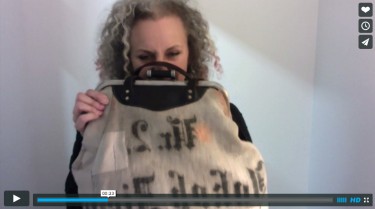
Worn Stories - Tamara Fogle Bag
Worn Stories by Emily Spivack is a series of stories revolving around our material connection to items in our wardrobe. This is one of a series of videos filmed at the BD+FA on individual worn stories.
Tamara Fogle bags, hand made in family run workshops in Notting Hill, London, combine antique textiles and leathers for unique, modern, timeless bags and purses. Bags are made with a range of unique antique materials, including German flour sacks, Hungarian grain sacks, French mattress ticking, canvas military tents and hand stitched quilts from Pakistan. Water-based aniline finished leather hides are used for the highly polished and sophisticated handles, patches and bases of the bags, making a wonderful contrast to the aged and faded material used for the body of the bags. Soft aniline finish hides use fewer chemicals through the tanning process than most other leathers, making them kinder to the environment, and giving them a more transparent finish, showing the natural markings and scars on the skin, and enhancing their individual character.
Each bag is a unique, one off piece, with materials ranging in age from the 1830’s to the 1940’s, some in perfect condition, with others featuring hand stitched repairs and darning, telling their unique stories and histories through their stains, distress and repairs from times past. The materials Fogle uses, are not merely last years discarded and unwanted textiles, but real antique materials, many dating from the early to mid-1800’s. Fogle’s background in antiques and interior styling has strongly influenced the design ethos of the brand, inspired by heritage, quality and the vibrance of London, Fogle’s bags have an instantly recognizable and unique charm.
Antique German flour sacks, dating from the 1830’s to the 1930’s, featuring black, often Gothic typography with the farmers name, the location of his farm and the year the sacks were used, sometimes strongly graphic and clearly legible, while others are beautifully faded, form the base material for Fogle’s iconic, historic bag collection. The age and original use of these sacks mean the materials can be very distressed, featuring marks, stains and repairs, enhancing the unique beauty and history of the materials. While most sacks from this time period were produced in one 100% linen, still retaining the strength and vibrancy of this durable material.
Antique Hungarian grain sacks, also hand-woven in 100% linen, date from 1910, through to the 1920’s. The simple red or blue stripe varies from sack to sack, and would have been distinct to each farmer. Bags made from antique French mattress ticking, date from the mid 1800’s, and are distinguished by the graduating color within each stripe, as well as the differentiation in tone from one stripe to the next, the bolder stipes dating from the 1950’s onward. Antique French linen, in varying shades of white and oatmeal, has varying textures, including slubby and smooth, while the vintage canvas military tent fabric, dating from the 1940’s, features wonderful muted tones of olive through brown. The vintage hand-stitched quilts from India and Pakistan, made from 100% cotton, with distinct patterns, weaves and prints, date from 1930’s to the 1970’s, and inject the collection with the vibrancy and color of these traditional materials.
Established in 2007, Fogle prides herself in ensuring the finest British quality production. Fabrics are re-used primarily for their aesthetic qualities, creating a smaller carbon footprint, and less waste en-route, however Fogle does not position the brand as either ethical or ecological, but never the less makes a significant impact with her conscience choice of materials and local, hand made production methodology.
Website: www.tamarafogle.com